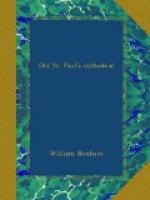“God save the King and Queen.”
(Guildhall Records.)
We have had the grand ceremonial at the Reconciliation to Rome. Another procession—oh! the pity of it—was held on St. Paul’s Day, 1550, of 160 priests, with Bishop Bonner at the head, singing their thanksgiving that the Queen was about to become a mother, and on the following April 30th, came the report that a prince was born. Again the bells rang out, and solemn Te Deum was sung! Machyn tells of the disappointment which followed, and expresses his hope for the future, hope not to be fulfilled.
What was it turned the tide of religious opinion? The answer admits of no doubt. John Rogers, the proto-martyr of the English Reformation, was a prebendary of St. Paul’s, a man of saintly life. He had given much help to Tyndale, the translator of the Bible, had brought the MS. to England, and published it. He was sentenced to be burned only three days after the reception of Pole, and died with dauntless courage, even his wife and children encouraging him. In the following October, his Bishop and patron, Ridley, also died the same fiery death. Machyn records, with apparent callousness, the burnings which went on in Smithfield day after day, along with trifling incidents and stately ceremonials at St. Paul’s. He does not realise that these things were horrifying the English people, and turning their hearts steadfastly to the persecuted faith. The greater number of the martyr fires took place in London, and St. Paul’s was the place of trial. On the 13th of November, 1558, the Queen issued a brief to Bonner, giving him command to burn heretics without mercy, and four days later she died, as, on the same day, did Cardinal Pole.




